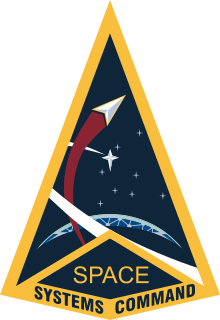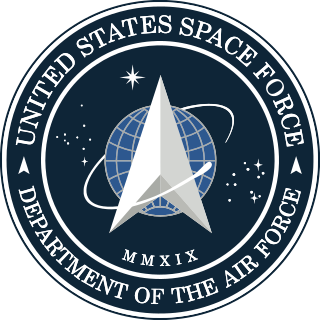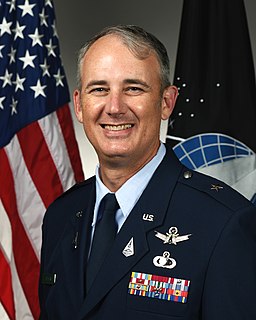
North American Aerospace Defense Command, known until March 1981 as the North American Air Defense Command, is a combined organization of the United States and Canada that provides aerospace warning, air sovereignty, and protection for Canada and the continental United States. Headquarters for NORAD and the NORAD/United States Northern Command (USNORTHCOM) center are located at Peterson Space Force Base in El Paso County, near Colorado Springs, Colorado. The nearby Cheyenne Mountain Complex has the Alternate Command Center. The NORAD commander and deputy commander (CINCNORAD) are, respectively, a United States four-star general or equivalent and a Canadian Lieutenant-general or equivalent.

ISTAR stands for intelligence, surveillance, target acquisition, and reconnaissance. In its macroscopic sense, ISTAR is a practice that links several battlefield functions together to assist a combat force in employing its sensors and managing the information they gather.

United States Space Command is a unified combatant command of the United States Department of Defense, responsible for military operations in outer space, specifically all operations 100 kilometers above mean sea level. U.S. Space Command is responsible for the operational employment of space forces that are provided by the uniformed services of the Department of Defense.

The Space-Based Infrared System (SBIRS) is a United States Space Force system intended to meet the United States' infrared space surveillance needs through the first two to three decades of the 21st century. The SBIRS program is designed to provide key capabilities in the areas of missile warning, missile defense and battlespace characterization via satellites in geosynchronous Earth orbit (GEO), sensors hosted on satellites in highly elliptical orbit (HEO), and ground-based data processing and control.

The United States Army Space and Missile Defense Command (USASMDC) is an Army Service Component Command (ASCC) of the United States Army. The command was established in 1997. The current USASMDC commander is Lieutenant General Daniel L. Karbler with Senior Enlisted Advisor Command Sergeant Major Finis A. Dodson.

United States Strategic Command (USSTRATCOM) is one of the eleven unified combatant commands in the United States Department of Defense. Headquartered at Offutt Air Force Base, Nebraska, USSTRATCOM is responsible for strategic nuclear deterrence, global strike, and operating the Defense Department's Global Information Grid. It also provides a host of capabilities to support the other combatant commands, including integrated missile defense; and global command, control, communications, computers, intelligence, surveillance, and reconnaissance (C4ISR). This command exists to give national leadership a unified resource for greater understanding of specific threats around the world and the means to respond to those threats rapidly.

Buckley Space Force Base is a United States Space Force base in Aurora, Colorado named after United States Army Air Service First Lieutenant John Harold Buckley. The base is run by Buckley Garrison, with major units including the U.S. Space Force's Space Delta 4, the Colorado Air National Guard's 140th Wing, the Denver Naval Operations Support Center, and the National Reconnaissance Office's Aerospace Data Facility-Colorado.
The Aerospace Corporation is an American nonprofit corporation that operates a federally funded research and development center (FFRDC) in El Segundo, California. The corporation provides technical guidance and advice on all aspects of space missions to military, civil, and commercial customers. As the FFRDC for national-security space, Aerospace works closely with organizations such as the United States Space Force and the National Reconnaissance Office (NRO) to provide "objective technical analyses and assessments for space programs that serve the national interest". Although the USSF and NRO are the primary customers, Aerospace also performs work for civil agencies such as NASA and NOAA as well as international organizations and governments in the national interest.

Space Systems Command (SSC) is the United States Space Force's space development, acquisition, launch, and logistics field command. It is headquartered at Los Angeles Air Force Base, California and manages the United States' space launch ranges.
The Operationally Responsive Space Office is a joint initiative of several agencies within the United States Department of Defense (DoD). The "stand up" of the office took place 21 May 2007 at Kirtland Air Force Base. The first director of the ORS Office was Col. Kevin McLaughlin, who was also dual-hatted as commander of the Space Development and Test Wing located at Kirtland. The ORS Office focuses on providing quick-response tactical space-based capabilities to the warfighter utilizing smaller satellites, such as the Tactical Satellite Program and smaller launch vehicles.

The Joint Tactical Ground Station (JTAGS) is the United States Army's element to United States Strategic Command's Theater Event System (TES). TES provides an integrated, in-theater, 24-hour overhead non-imaging infrared detection capability for processing and disseminating missile early warning, alerting, and cueing information data to combatant commanders and missile defense assets through the use of stereo processing of the Defense Support Program (DSP) satellite data.

The Missile Warning Center (MWC) is a center that provides missile warning and defense for United States Space Command's Combined Force Space Component Command, incorporating both space-based and terrestrial sensors. The MWC is located at Cheyenne Mountain Space Force Station.

USA-273, also known as SBIRS GEO-3, is a United States military satellite and part of the Space-Based Infrared System (SBIRS).

The United States Space Force (USSF) is the space service branch of the U.S. Armed Forces, one of the eight U.S. uniformed services, and currently the world's only independent space force. Along with its sister branch, the U.S. Air Force, the Space Force is part of the Department of the Air Force, one of the three civilian-led military departments within the Department of Defense. The Space Force, through the Department of the Air Force, is overseen by the secretary of the Air Force, a civilian political appointee who reports to the secretary of defense, and is appointed by the president with Senate confirmation. The military head of the Space Force is the chief of space operations who is typically the most senior Space Force officer. The chief of space operations exercises supervision over the Space Force's units and serves as one of the Joint Chiefs of Staff.

The Combined Force Space Component Command (CFSCC) is a U.S.–led multinational subordinate command of United States Space Command. It is responsible for tactical control of American and multinational space forces. The CFSCC's mission is to "plan, integrate, conduct, and assess global space operations in order to deliver combat relevant space capabilities to Combatant Commanders, Coalition partners, the Joint Force, and the Nation." It was established on 29 August 2019.

Donald Jason Cothern is a brigadier general in the United States Space Force currently serving as the deputy commander of the Space Systems Command. He transferred to the Space Force from the United States Air Force in May 2021.

Space Delta 4 is a United States Space Force unit responsible for providing strategic and theater missile warning to the United States and its international partners. It operates three constellations of Overhead Persistent Infrared (OPIR) satellites and two types of Ground-Based Radars (GBRs) for the purpose of conducting strategic and theater missile warning. Additionally, DEL 4 provides tipping and cueing to missile defense forces, battlespace awareness to combatant commanders and technical intelligence for further analysis and manages weapon system architectures and ensures operations are intelligence-led, cyber-resilient, and driven by innovation, while postured to operate in a contested, degraded, and operationally-limited environment.

The United States Space Force is organized by different units: the Space Staff, the field commands, and the space deltas.

While the United States Space Force gained its independence on 20 December 2019, the history of the United States Space Force can be traced back to the beginnings of the military space program following the conclusion of the Second World War in 1945. Early military space development was begun within the United States Army Air Forces by General Henry H. Arnold, who identified space as a crucial military arena decades before the first spaceflight. Gaining its independence from the Army on 18 September 1947, the United States Air Force began development of military space and ballistic missile programs, while also competing with the United States Army and United States Navy for the space mission.

The Space Development Agency (SDA) is a directorate of the United States Department of Defense's office of the under secretary of defense for research and engineering which supports space development in the interests of U.S. national security. By design, the functions for acquisition and sustainment (A&S) are the responsibility of another under secretary of defense; this separation of function decouples the technology development of a working prototype system, even the systems as complicated as those taken on by the SDA, from overcomplication induced by the processes of the DoD.



















